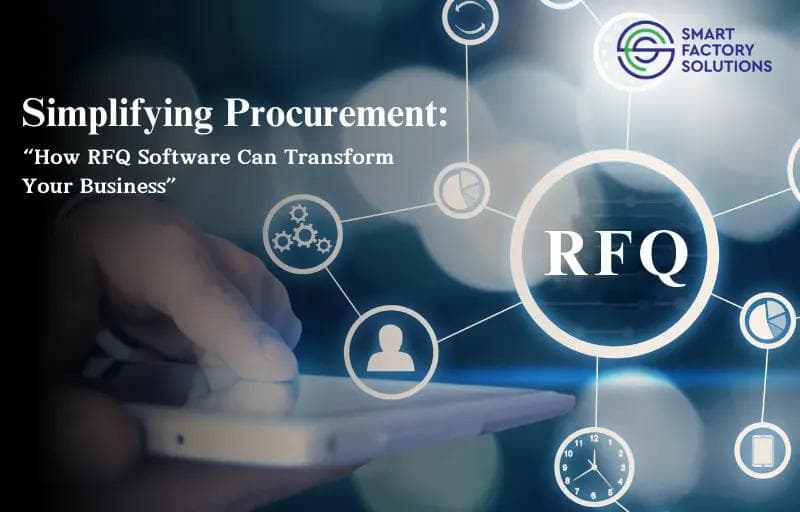Back
Streamlining Your Procurement Process with Request for Quote (RFQ) Software

Streamlining Your Procurement Process with Request for Quote (RFQ) Software
In today's competitive business landscape, efficient procurement processes are vital for maintaining cost control, ensuring quality, and fostering strong supplier relationships. One powerful tool that can significantly enhance your procurement strategy is Request for Quote (RFQ) software. In this blog post, we'll explore what RFQ software is, its key benefits, and how it can streamline your procurement process.
What is RFQ Software?
RFQ software automates and streamlines the process of soliciting and evaluating quotes from suppliers. It replaces traditional, manual methods of managing RFQs—such as emails, spreadsheets, and paper documents—with a centralized, digital platform. This software helps businesses efficiently handle the entire RFQ process, from creating and sending RFQs to comparing quotes and awarding contracts.
RFQ software typically includes features such as templates for creating RFQs, tools for managing supplier responses, and analytics for evaluating quotes. These features make it easier to ensure that all suppliers receive the same information, submit their quotes on time, and adhere to the required specifications. The software can also integrate with other business systems, such as ERP (Enterprise Resource Planning) and CRM (Customer Relationship Management) platforms, to provide a seamless flow of information across the organization.
Key Benefits of RFQ Software

1. Improved Efficiency and Time Savings
Manual RFQ processes can be time-consuming and prone to errors. Procurement professionals often spend countless hours sending out RFQs, tracking responses, and compiling data from multiple suppliers. RFQ software automates these repetitive tasks, freeing up valuable time that can be better spent on more strategic activities, such as negotiating with suppliers or analyzing market trends.
Automation ensures that RFQs are sent out promptly and that responses are tracked in real time. This not only speeds up the procurement process but also reduces the risk of missing critical deadlines. With RFQ software, you can set up automatic reminders and notifications to ensure that suppliers respond on time and that procurement activities stay on schedule.
2. Enhanced Accuracy and Consistency
With RFQ software, you can ensure that all suppliers receive the same information and that their responses are evaluated consistently. This standardization reduces the risk of miscommunication and errors, leading to more accurate and reliable procurement decisions. The software allows you to create standardized templates for RFQs, which helps in maintaining consistency in the information shared with suppliers.
Additionally, RFQ software can automatically validate supplier responses against predefined criteria, ensuring that all submissions meet the required standards. This feature eliminates the need for manual verification and reduces the likelihood of errors or omissions in the evaluation process.
3. Better Supplier Management
RFQ software often includes features for managing supplier information, performance tracking, and communication history. This comprehensive view of supplier relationships helps you make informed decisions and build stronger partnerships. You can store all supplier-related data in a centralized database, making it easy to access and update information as needed.
The software also allows you to track supplier performance over time, using key performance indicators (KPIs) such as delivery times, quality of goods, and responsiveness. This data can be used to identify top-performing suppliers and address any issues with underperforming ones. By having a clear understanding of supplier performance, you can negotiate better terms and conditions, foster long-term partnerships, and ensure a reliable supply chain.
4. Cost Savings
By automating the RFQ process, you can reduce administrative costs and achieve better pricing from suppliers. The software facilitates competitive bidding, enabling you to identify the most cost-effective options without sacrificing quality. RFQ software makes it easy to compare quotes from multiple suppliers, ensuring that you get the best possible deal for your organization.
Moreover, the software provides insights into spending patterns and supplier pricing trends, helping you identify opportunities for cost savings. By analyzing this data, you can make informed decisions about where to cut costs and how to optimize your procurement strategy.
5. Enhanced Collaboration and Transparency
RFQ software provides a centralized platform where all stakeholders can access and review RFQ documents, supplier responses, and evaluation results. This transparency fosters better collaboration and ensures everyone is on the same page. Team members can easily share information, provide feedback, and collaborate on decision-making, regardless of their location.
The software also includes features for tracking and auditing all procurement activities, ensuring compliance with internal policies and external regulations. This level of transparency and accountability helps build trust among stakeholders and supports a more efficient and effective procurement process.
Key Features to Look for in RFQ Software
When choosing RFQ software for your business, consider the following key features:
User-Friendly Interface: Ensure the software is intuitive and easy to use for all stakeholders involved in the RFQ process. A user-friendly interface reduces the learning curve and encourages adoption across the organization.
Customization: Look for software that allows you to customize RFQ templates, evaluation criteria, and reporting tools to fit your specific needs. Customization ensures that the software can adapt to your unique procurement processes and requirements.
Integration: The ability to integrate with your existing procurement, ERP, and accounting systems is crucial for seamless operations. Integration ensures that data flows smoothly between different systems, reducing the need for manual data entry and minimizing the risk of errors.
Supplier Portal: A dedicated portal for suppliers to submit their quotes and communicate with your team can enhance efficiency and supplier engagement. The portal should be easy to use and provide suppliers with all the information they need to submit accurate and timely quotes.
Analytics and Reporting: Robust analytics and reporting features help you gain insights into your RFQ processes and make data-driven decisions. Look for software that offers customizable reports, dashboards, and analytics tools to track key metrics and monitor performance.
Security: Ensure the software has robust security measures in place to protect sensitive procurement data. Look for features such as data encryption, user authentication, and access controls to safeguard your information.
How to Implement RFQ Software Successfully
1. Assess Your Needs
Before selecting RFQ software:
- Evaluate your current procurement processes and identify areas for improvement.
- Determine what features are most important for your business and set clear goals for what you want to achieve with the software.
- Consider factors such as the volume of RFQs you handle, the complexity of your procurement processes, and the level of supplier engagement you require.
2. Choose the Right Software
Research and compare different RFQ software options based on your needs and budget. Look for customer reviews, request demos, and consider reaching out to other businesses in your industry for recommendations. Take the time to evaluate each option thoroughly and ensure that it aligns with your procurement goals and objectives.
3. Plan for Integration
Work with your IT team to ensure the RFQ software integrates smoothly with your existing systems. Proper integration is crucial for maximizing the software's benefits. Create a detailed integration plan that outlines the steps and timelines for connecting the RFQ software with your ERP, CRM, and other relevant systems.
4. Train Your Team
Provide comprehensive training to all users to ensure they understand how to use the software effectively. Consider ongoing training sessions to keep everyone up to date with new features and best practices. Training should cover all aspects of the software, from creating and sending RFQs to evaluating supplier responses and generating reports.
5. Monitor and Optimize
After implementation, regularly review the performance of your RFQ software and gather feedback from users. Use this information to make continuous improvements and ensure the software continues to meet your evolving needs. Set up regular check-ins with your procurement team to discuss any challenges or opportunities for optimization.
Analyze the software's data to identify trends, track performance, and make informed decisions. Use this information to refine your procurement strategy, improve supplier relationships, and achieve your procurement goals.
Conclusion
RFQ software is a powerful tool that can transform your procurement process by enhancing efficiency, accuracy, and collaboration. By choosing the right software and implementing it effectively, you can achieve significant cost savings and build stronger supplier relationships. Embrace the future of procurement with RFQ software and position your business for success in today's competitive market.
Implementing RFQ software requires careful planning, training, and ongoing optimization, but the benefits far outweigh the initial investment. With improved efficiency, better supplier management, and enhanced collaboration, RFQ software can help you achieve a more streamlined and effective procurement process. By leveraging the power of automation and data analytics, you can make smarter procurement decisions and drive your business forward.



